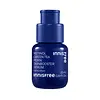What's inside
What's inside
 Key Ingredients
Key Ingredients

 Benefits
Benefits

 Concerns
Concerns

 Ingredients Side-by-side
Ingredients Side-by-side

Lactobacillus Ferment Lysate
Skin ConditioningGlycerin
HumectantPropanediol
SolventWater
Skin ConditioningDipropylene Glycol
HumectantButylene Glycol
HumectantNiacinamide
Smoothing1,2-Hexanediol
Skin ConditioningSqualane
EmollientGlyceryl Polymethacrylate
Dimethyl Isosorbide
SolventMethyl Trimethicone
Skin ConditioningCetearyl Alcohol
EmollientHydroxyethyl Urea
HumectantAmmonium Acryloyldimethyltaurate/Vp Copolymer
Helianthus Annuus Seed Oil
EmollientGlycine Soja Oil
EmollientAllantoin
Skin ConditioningGlyceryl Stearate
EmollientXanthan Gum
EmulsifyingTocopherol
AntioxidantTocopheryl Acetate
AntioxidantPentylene Glycol
Skin ConditioningDipotassium Glycyrrhizate
HumectantSodium Stearoyl Glutamate
CleansingHydrogenated Lecithin
EmulsifyingDaucus Carota Sativa Root Extract
Skin ConditioningHydroxypinacolone Retinoate
Skin ConditioningStearic Acid
CleansingPolyglyceryl-3 Methylglucose Distearate
EmulsifyingSodium Polyacrylate
AbsorbentSodium Metaphosphate
BufferingKojyl Methylenedioxycinnamate
AntioxidantPalmitic Acid
EmollientEthylhexylglycerin
Skin ConditioningAdenosine
Skin ConditioningRetinol
Skin ConditioningSodium Hyaluronate
HumectantHyaluronic Acid
HumectantHydrolyzed Vegetable Protein
Skin ConditioningAchillea Millefolium Extract
CleansingZea Mays Oil
EmulsifyingMyristic Acid
CleansingLauric Acid
CleansingPullulan
Zein
Skin ConditioningCamellia Sinensis Leaf Extract
AntimicrobialPectin
Emulsion StabilisingCitric Acid
BufferingLactobacillus Ferment Lysate, Glycerin, Propanediol, Water, Dipropylene Glycol, Butylene Glycol, Niacinamide, 1,2-Hexanediol, Squalane, Glyceryl Polymethacrylate, Dimethyl Isosorbide, Methyl Trimethicone, Cetearyl Alcohol, Hydroxyethyl Urea, Ammonium Acryloyldimethyltaurate/Vp Copolymer, Helianthus Annuus Seed Oil, Glycine Soja Oil, Allantoin, Glyceryl Stearate, Xanthan Gum, Tocopherol, Tocopheryl Acetate, Pentylene Glycol, Dipotassium Glycyrrhizate, Sodium Stearoyl Glutamate, Hydrogenated Lecithin, Daucus Carota Sativa Root Extract, Hydroxypinacolone Retinoate, Stearic Acid, Polyglyceryl-3 Methylglucose Distearate, Sodium Polyacrylate, Sodium Metaphosphate, Kojyl Methylenedioxycinnamate, Palmitic Acid, Ethylhexylglycerin, Adenosine, Retinol, Sodium Hyaluronate, Hyaluronic Acid, Hydrolyzed Vegetable Protein, Achillea Millefolium Extract, Zea Mays Oil, Myristic Acid, Lauric Acid, Pullulan, Zein, Camellia Sinensis Leaf Extract, Pectin, Citric Acid
 Reviews
Reviews

Ingredients Explained
These ingredients are found in both products.
Ingredients higher up in an ingredient list are typically present in a larger amount.
Retinol is a gold-standard ingredient for anti-aging. It is a form of Vitamin A and belongs to the class of retinoids that also includes tretinoin.
Why is retinol famous?
It has the most scientific studies backing up its skin benefits out of all the non-prescription ingredients.
Retinol is proven to:
This is why retinol is effective at removing wrinkles, fading dark spots, treating acne, and reducing the appearance of pores.
Studies show retinol is less effective when exposed to UV. Be sure to look for appropriate packaging to keep your retinol potent (similar to Vitamin C).
Using retinol or any retinoids will increase sun-sensitivity in the first few months. Though studies show retinoids increase your skin's natural SPF with continuous use, it is best to always wear sunscreen and sun-protection.
We recommend speaking with a medical professional about using this ingredient during pregnancy.
Retinol may cause irritation in some people, so be sure to patch test. Experts recommend 'ramping up' retinol use: start using this ingredient once a week and work up to using it daily.
Read about Tretinoin
Learn more about RetinolSqualane is an emollient that helps the skin hold onto moisture. It's an oily liquid that occurs naturally in certain types of fish and plant oils.
Because squalane boosts hydration in the skin, it also comes with plenty of benefits: it is an antioxidant and can help fight free radicals and skin damage. Squalane is also found to have a detoxifying effect when applied.
Squalane comes from squalene, which occurs naturally within the sebum of our skin. It is one of the oils our skin produces to keep itself hydrated. Squalane is the hydrogenated version of squalene and has a longer shelf life.
Research shows that squalane is non-irritating (even at 100% concentration).
In general, it's a fantastic ingredient. It does a great job at hydrating the skin, and it's suitable for those with sensitive skin.
The source of squalane may impact malassezia / fungal acne. This is because olive oil derived squalane can contain impurities such as fatty acids and plant waxes. Sugarcane derived squalane is recommended for anyone with malassezia concerns.
Is squalane vegan?
This depends on the source. Squalane can be derived from both plants and animals. Most squalane used in skincare comes from plants.
Please note: the source of squalane is only known if disclosed by the brand. We recommend reaching out to the brand if you have any questions about their squalane.
Read more about squalene with an "e".
Is squalane an oil?
Squalane is often called an oil, but it’s technically not; it’s a hydrocarbon, meaning it’s only made of carbon and hydrogen, unlike true oils which are triglycerides made of fatty acids and glycerol.
The term “oil-free” isn’t regulated, so companies can define it however they want. Some exclude all oils, while others just avoid mineral oil or comedogenic oils.
While some people avoid oils thinking they cause breakouts, the right kind of oil (or oil-like ingredient like squalane) can actually help balance and hydrate your skin. It’s worth testing out simple oils or squalane to see what works best for your skin.
Learn more about Squalane